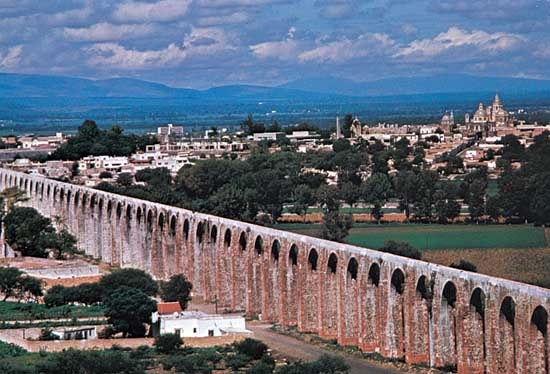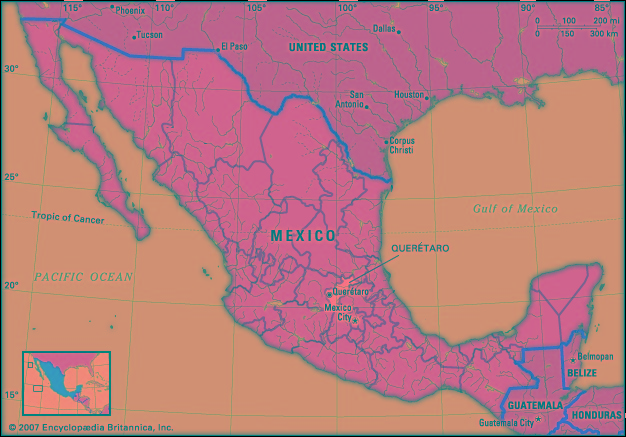Querétaro
Mexico
in full Santiago de Querétaro
 city, capital of Querétaro estado (state), central Mexico. Situated on the Mexican Plateau at an elevation of about 6,100 feet (1,860 metres) above sea level, it is some 130 miles (210 km) northwest of Mexico City. Querétaro is considered an excellent example of a Spanish colonial city; its well-preserved historic centre was designated a UNESCO World Heritage site in 1996.
city, capital of Querétaro estado (state), central Mexico. Situated on the Mexican Plateau at an elevation of about 6,100 feet (1,860 metres) above sea level, it is some 130 miles (210 km) northwest of Mexico City. Querétaro is considered an excellent example of a Spanish colonial city; its well-preserved historic centre was designated a UNESCO World Heritage site in 1996.Querétaro was founded by Otomí Indians and was incorporated into the Aztec empire in 1446. Until 1531, when it was brought under Spanish control, it served as an Otomí outpost against enemies to the north. It was noted for its multiethnic blend of Otomí, Tarascan, Chichimec, and Spanish residents throughout most of the colonial period. Querétaro, a major base for the Franciscans' missionary work in North America, served as a way station and supply centre for the rich mining districts of Guanajuato and Zacatecas. In 1810 it was the scene of a plot against Spain that led to the uprising headed by Miguel Hidalgo y Costilla (Hidalgo y Costilla, Miguel) in September of that year. In 1848 the Treaty of Guadalupe Hidalgo (Guadalupe Hidalgo, Treaty of), terminating the Mexican War, was signed there. The forces of Benito Juárez (Juárez, Benito) defeated those of the emperor Maximilian at Querétaro in 1867, and Maximilian and his generals were executed by firing squads on a nearby hill. The Mexican Constitution of 1917 was written in Querétaro, and the city was also the birthplace of Mexico's Institutional Revolutionary Party in 1929.
Central Querétaro retains its narrow, twisting colonial-era alleys amid stone streets in a grid pattern. Among its historic structures are the cathedral (restored several times), the municipal palace, and the churches of Santa Rosa de Viterbo, Santa Clara, and San Agustín. A prominent feature is an aqueduct 5.5 miles (9 km) long—some 4,200 feet (1,280 metres) of it borne on 74 stone piers up to 75 feet (23 metres) high—built in the 1720s and '30s to transport water to the city from nearby springs.
One of Mexico's oldest and largest cotton mills is located in Querétaro, which also produces textiles and pottery and processes crops from its agricultural hinterland. Other manufactures include automobile parts, heavy machinery, oil-drilling equipment, food products, and consumer goods. The Autonomous University of Querétaro (1951) and the Regional Museum of Querétaro (1936) are located in the city. Querétaro lies at the junction of major railway lines to Mexico City, to which it is also linked by highway and air. Pop. (2000) city, 536,463; urban agglom., 787,341.
state, Mexico
in full Querétaro de Arteaga

 estado (state), central Mexico. It is bounded by the states of San Luis Potosí to the north and northeast, Hidalgo and México to the southeast, Michoacán to the southwest, and Guanajuato to the west. The capital is the city of Querétaro (Santiago de Querétaro).
estado (state), central Mexico. It is bounded by the states of San Luis Potosí to the north and northeast, Hidalgo and México to the southeast, Michoacán to the southwest, and Guanajuato to the west. The capital is the city of Querétaro (Santiago de Querétaro).Querétaro, one of the smallest states in Mexico, is situated on the Mesa Central. Its relief is divided between mountainous areas in the north and rolling plains and fertile intermontane valleys in the south and west, where most of the population is concentrated in and around Querétaro city. Industrial complexes at the capital and at the city of San Juan del Río produce metal goods, machinery, chemicals, and processed foods, but the service sector (including government and retail trade) accounts for a much larger share of employment. In the southern lowlands a variety of crops are cultivated, including fruits, corn (maize), grains, and medicinal plants. The breeding of fighting bulls is a traditional activity. The main Juárez– Mexico City highway and railroad traverse the state.
The Spanish conquered the Otomí and Chichimec Indians in the region in 1531, and colonization began in the 1550s. Communities in the Sierra Gorda, in the north of the state, remained culturally autonomous until the mid-1700s, when Franciscan missionaries arrived there; their efforts, still visible in a group of well-preserved mission churches, were collectively designated a UNESCO World Heritage site in 2003. During the colonial period, Querétaro city was remarkable for its ethnically mixed Otomí, Tarasco, Chichimec, and Spanish populations. The region was administered with Guanajuato before it became a state in 1824.
State government is headed by a governor, who is elected to a single term of six years. Members of the unicameral State Legislature are elected to three-year terms. Querétaro is divided into local governmental units called municipios (municipalities), each of which is headquartered in a prominent city, town, or village. The state's cultural institutions include the Autonomous University of Querétaro (1951) and the Regional Museum of Querétaro (1936), both located in the capital city. The colonial centre of Querétaro city was designated a World Heritage site in 1996; one of the city's most striking features is an aqueduct built in the 1720s and '30s to bring in water from nearby springs. Area 4,420 square miles (11,449 square km). Pop. (2000) 1,404,306; (2005) 1,598,139.
- Ochnaceae
- Ochoa, Ellen
- Ochoa, Severo
- Ocho Rios
- Ochs, Adolph Simon
- Ochsenbein, Ulrich
- Ochs, Peter
- Ochs, Phil
- Ockeghem, Jean de
- Ockham's razor
- Ockham, William of
- O'Clery, Michael
- Ocoee River
- Oconee
- O'Connell, Daniel
- O'Connell, David
- O'Connor, Donald
- O'Connor, Feargus Edward
- O'Connor, Flannery
- O'Connor, Frank
- O'Connor, John Joseph Cardinal
- O'Connor, Sandra Day
- Oconto
- Ocotal
- ocotillo